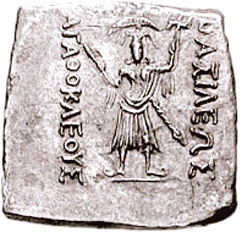삼카르사나
| 삼카르사나 | |
|---|---|
| 바가바트교의 영웅신 | |
 | |
| 소속 | 브리슈니 영웅신 |
| 신앙 중심지 | 마투라 |
| 지역 | 수라세나 |
| 민족 | 브리슈니족 |
| 형제자매 | 바가바트 |
| 그리스 동등신 | 헤라클레스 |
| 힌두 동등신 | 발라라마 |
삼카르사나(Saṃkarṣaṇa)는 마투라 지역에 거주하던 브리슈니족의 왕 바수데바 아난카둔두비의 아들이다.[1] 그는 브리슈니 영웅들의 주요 멤버였으며, 마투라 지역의 고대 역사적 지도자였을 것이다.[1][2][3][4] 바수데바와 함께 삼카르사나를 숭배하는 것은 역사적으로 기원전 4세기경에 입증된 인도의 가장 초기 형태의 개인적인 신 숭배 중 하나이다.[5][6][7]
바수데바와 삼카르사나는 나라야나, 슈리, 락슈미 등과 함께 주요 독립 교파 중 하나로, 나중에 비슈누교를 형성하기 위해 연합했다.[8] 비슈누파의 아바타라 교리에 따르면, 비슈누는 세계를 구하기 위해 다양한 형태를 취하는데 바수데바뿐만 아니라 삼카르사나도 이러한 형태 중 일부이며, 가장 인기 있는 형태로 이해하게 되었다.[9] 이 과정은 바수데바와 삼카르사나가 독립적인 신이었던 기원전 4세기부터 비슈누가 통합된 비슈누파 교파의 중심적인 신으로 훨씬 더 부각된 서기 4세기까지 지속되었으며, 바수데바와 삼카르사나는 그의 모습 중 일부일 뿐이다.[9]
삼카르사나는 서사시와 푸라나에서 라마, 발라데바, 발라라마, 라우히네야 또는 할라유다라는 이름으로도 알려져 있으며 바수데바의 형으로 제시된다.[10]
처음에는 삼카르사나가 동생 바수데바보다 우선하는 것으로 보이는데, 이는 그가 박트리아의 아가토클레스 왕(기원전 190년경-180년경)의 동전에 등장하는 것이며, 일반적으로 고순디 비문에서와 같은 이름 순서로 첫 번째에 등장한다.[11] 이후 이 순서는 뒤바뀌었고, 바수데바는 가장 중요한 신이 되었다.[11]
같이 보기[편집]
각주[편집]
- ↑ 가 나 Vāsudeva and Krishna "may well have been kings of this dynasty as well" in Rosenfield, John M. (1967). 《The Dynastic Arts of the Kushans》 (영어). University of California Press. 151–152 and Fig.51쪽.
- ↑ Williams, Joanna Gottfried (1981). 《Kalādarśana: American Studies in the Art of India》 (영어). BRILL. 129쪽. ISBN 978-90-04-06498-0.
- ↑ Paul, Pran Gopal; Paul, Debjani (1989). “Brahmanical Imagery in the Kuṣāṇa Art of Mathurā: Tradition and Innovations”. 《East and West》 39 (1/4): 132–136, for the photograph p.138. ISSN 0012-8376. JSTOR 29756891.
- ↑ Smagur, Emilia. “Vaishnavite Influences in the Kushan Coinage, Notae Numismaticae- Zapiski Numizmatyczne, X (2015)” (영어): 67.
- ↑ Doris Srinivasan (1997). 《Many Heads, Arms, and Eyes: Origin, Meaning, and Form of Multiplicity in Indian Art》. BRILL Academic. 211–220, 236쪽. ISBN 90-04-10758-4.
- ↑ Gavin D. Flood (1996). 《An Introduction to Hinduism》. Cambridge University Press. 119–120쪽. ISBN 978-0-521-43878-0.
- ↑ Christopher Austin (2018). Diana Dimitrova and Tatiana Oranskaia, 편집. 《Divinizing in South Asian Traditions》. Taylor & Francis. 30–35쪽. ISBN 978-1-351-12360-0.
- ↑ Singh, Upinder (2008). 《A History of Ancient and Early Medieval India: From the Stone Age to the 12th Century》 (영어). Pearson Education India. 436–438쪽. ISBN 978-81-317-1120-0.
- ↑ 가 나 Curta, Florin; Holt, Andrew (2016). 《Great Events in Religion: An Encyclopedia of Pivotal Events in Religious History [3 volumes]》 (영어). ABC-CLIO. 271쪽. ISBN 978-1-61069-566-4.
- ↑ Austin, Christopher R. (2019). 《Pradyumna: Lover, Magician, and Scion of the Avatara》 (영어). Oxford University Press. 24쪽. ISBN 978-0-19-005412-0.
- ↑ 가 나 Austin, Christopher R. (2019). 《Pradyumna: Lover, Magician, and Scion of the Avatara》 (영어). Oxford University Press. 22쪽. ISBN 978-0-19-005412-0.

|
이 글은 종교에 관한 토막글입니다. 여러분의 지식으로 알차게 문서를 완성해 갑시다. |



